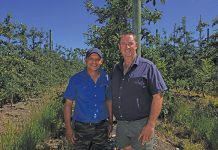
So, to avoid overdosing your crop and wasting money, it’s crucial to calibrate your sprayer correctly. The first step is to ensure that you have the correct nozzles. Don’t become lazy and use the same nozzles for both weedkillers and pests.
Remember that both the nozzle aperture and the spray pressure determine the droplet size. And try to ensure accuracy at all times – prevent the product from drifting away from the target.
This aspect is especially important when using weedkillers on foliage. If you employ a contact product such as Paraquat, you may need a finer droplet to cover the foliage effectively, but it should not be so fine that it drifts into non-target areas or is in danger of being inhaled by the operator. On the other hand, systemic products such as glyphosate travel within the capillaries of the plant, so you can use a coarser droplet and only as much water as is necessary to get an even distribution.
How to calibrate correctly
The actual calibration is best done on a straight section of road. Mark out a 100m stretch and determine your tractor’s spraying speed. Mark the engine rpm at this speed on the rev counter with a felt-tipped pen and record the gear used on some convenient spot. Next, measure the time it takes the tractor to travel the 100m. A fairly typical time would be, say, a minute. The effective width of the spray boom multiplied by 100m will give you how much area you’ll spray over this distance. A 5m-wide boom means that you cover 500m2 for every 100m travelled.
Next, fill the tank with water and set the pressure required to achieve the correct droplet size. Draw a line on the pressure gauge with a black marker to record this. With the tractor stationary and running at the required rpm, place a graduated container under a nozzle for the length of time it took the tractor to travel the 100m – in this case, one minute. Let’s say that you end up with one litre in the container. Multiply this by the number of nozzles (say, 18 in all) and you will get the total number of litres used to spray 500m2 – in this case, 18l.
Establishing total quantity required
You can now work out how many litres/ha you will require. In this example, you’ve used 18l on 500m2, which is 1/20th of a hectare. So you would use 18 x 20 = 360l/ha. Be aware that your speed will vary somewhat due to variations in the surface of the land. Bearing in mind that the output per nozzle per minute will remain the same, measure the length of the land, then the time taken to travel from one end to the other. Comparing this with your test measurement will enable you to work out how much fine-tuning you need to do.
Finally, check that all the nozzles are the same size and that the spray pattern is uniform for each nozzle when looking from behind. Do spot checks from time to time.






